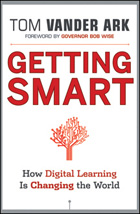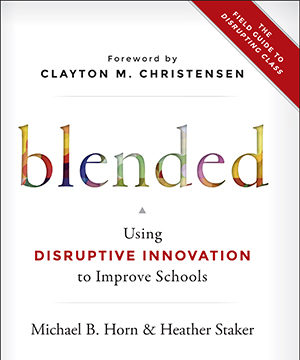 The Race between Education and Technology
The Race between Education and Technology
By Claudia Goldin and Lawrence F. Katz
Belknap Press, 2008, $39.95; 496 pages.
As reviewed by Daniel Gross
Many of the briefs for American exceptionalism, from de Tocqueville’s Democracy in America to Louis Hartz’s The Liberal Tradition in America, focus on the nation’s political and economic systems. Claudia Goldin and Lawrence Katz, two historically minded economists, advance the claim that America has followed a path of development unique among nations by rapidly building a comprehensive education system. Ultimately, they argue, America surged to global preeminence and created immense, widespread wealth by turning what was once the province of the elite into a utility for the masses. “That the twentieth century was both the American Century and the Human Capital Century is no historical accident,” the authors write. “The nation that invested the most in education, and did much of that investment during the century in which education would critically matter, was the nation that had the highest level of per capita income.”
Goldin and Katz delineate the historical process through which technology and education encouraged economic growth. It’s not quite a dialectic, but more of a race “between the growth in the demand for skills driven by technological advances and the growth in the supply of skills driven by demographic change, educational investment choices, and immigration.” But the story of the race is also a cautionary tale of how progress has stalled in the past 30 years, contributing to corrosive inequality and “late twentieth-century angst.” Goldin, professor of economics at Harvard, and Katz, a Harvard professor of economics who worked as chief economist at the Labor Department, cover subjects that generate a great deal of cable-news and op-ed-page heat, such as the stagnation of incomes and the failures of public education. But partisans expecting to have their biases confirmed won’t find much succor here. The book’s conclusions are based not on talking points but on deep dives into data, like the 1915 Iowa Census, and much considered number crunching.
The story starts in the early 19th century, when the “virtues” of the American education system took shape. By virtues, Goldin and Katz mean “a set of characteristics that originated in basic democratic and egalitarian principles and that influenced the educational system.” Among them were public funding, decentralization, the separation of church and state, an open and forgiving structure, and a lack of gender bias. The result: “By the middle of the nineteenth century the United States had the most educated youth in the world.”
When most of those youths were working on the farm, all that elementary education didn’t give America much of an edge. But at the turn of the 20th century, the introduction of electricity and the widespread adoption of capital-intensive technologies boosted the demand for skilled mechanics, technicians, clerks—people who could read manuals and do algebra. By 1920, Goldin and Katz found, more than one-quarter of workers had jobs in occupations for which a high school or college education was expected. This change spurred the wholesale construction and development of a post-elementary school system. By 1940, 70 percent of American youths were enrolled in high school. The result of the rapidly expanding supply of high-school-educated workers was, ironically, a diminishing return on the investment. In the first half of the 20th century, the high school wage premium, the amount of money high school graduates earned greater than those who hadn’t graduated, declined.
Americans didn’t respond to such diminished returns by cutting back on education. Quite the opposite. The revolution in high school education was closely followed by a rapid expansion in higher education. About 4 percent of those born in 1900 would graduate from a four-year college; 24 percent of those born in 1950 would. Once again, the rising supply of alumni helped shrink the wage premium that accrued to those with college educations. And so in the middle decades of the 20th century, the U.S. experienced excellent economic growth without noticeable increases in inequality.
But the uniquely American process of expanding educational achievement and income compression ground to a halt in the 1970s. High school graduation rates stopped rising, and college completion rates—for decades the envy of the world—haven’t kept pace with those of many other developed countries. “Clearly, the United States no longer leads the world in the education of young adults,” the authors write. More worrisome, and not coincidentally, productivity growth has sagged and income inequality has spiked to levels not seen since the 1920s. How are these phenomena related? It’s a simple matter of supply and demand, explain Goldin and Katz. In the past 30 years, the demand for workers with a college education (driven in large part by advances in technology) has continued to rise steadily, but supply hasn’t kept up. From 1960 to 1980, they write, the relative supply of college workers rose 3.77 percent per year, but between 1980 and 2005 it rose just 2 percent annually. The result: a rising premium for college-educated workers. “Overall, simple supply and demand specifications do a remarkable job of explaining the long-run evolution of the college wage premium.” Thus the imperative is to increase the supply of better-educated workers by improving education, starting with preschool and ending with more financial aid for college students.
It’s a compelling argument that masterfully applies cool reason and data to hot-button contemporary issues. But one may wonder whether the complex question can be so easily reduced to the supply and demand of college-educated workers. For example, many economists believe the rapid influx of comparatively less-educated foreign immigrants has been a factor in suppressing wage growth at the lower end of the income scale (and hence in increasing inequality). Goldin and Katz characterize any impact from immigration as “a small drag,” and “modest compared with the changes for the native-born population.” I put down the book thinking that the two highly rational economists hadn’t grappled with some of the noneconomic forces that are contributing to depressed achievement. Consider this paradox: The economic returns to higher education are as good as they’ve been at any time in the past century. And yet for three decades, Americans, who have generally shown themselves to be rational economic actors, haven’t been pursuing the profitable path of education in sufficient numbers. Clearly, there are deeply rooted social, psychological, and cultural factors that explain why significant portions of the population don’t see the apparently obvious connection between education and economic well-being. If the solution to the problems of educational achievement were as simple as boosting financial aid and providing more funds to preschools, a few well-intentioned foundations could easily transform large chunks of the education system.
Daniel Gross, the author of several books on U.S. economic and business history, is a columnist at Newsweek.





